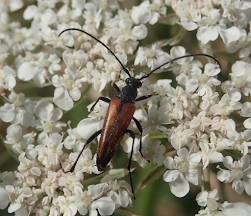Hitchin Cemetery June-July 2024
Hitchin Cemetery June-July 2024
The fourth and final cemetery tour led by The Friends of Hitchin Cemetery as part of Hitchin Festival was on the last Sunday of July and there have been nearly 100 visitors on tours this year. The tours start in the chapel to give people a chance to see inside this building, which is not often used, although this year for the first time the chapel was used as a voting station in the general election. Apologies to the many people who have been unable to book on these very popular tours: we will give the disappointed people prior notice of next year's tours.
The summer months are the best time to see the many flowers and insects which find a home in the cemetery. There have been some really very unusual wildlife sightings (as you will see lower down) which is remarkable given that it is only eight years since a changed management scheme allowed some grassland areas of the cemetery to grow long. It is also eight years since The Friends of Hitchin Cemetery was founded. Maybe if some verges and greenspaces around town are managed differently they too may see improvements in biodiversity.
Two insects which are seen regularly are the Two-banded Spearhorn hoverfly and the Fairy-ring Longhorn beetle. Both of these species are found in good quality grassland. The Fairy-ring Longhorn beetle takes its name because its larvae eat the fungus which causes fairy-rings on lawns.
There are plenty of the yellow flowers of Perforated St John's Wort (this seems appropriate that the cemetery is on St. John's Road). The photograph below left shows the leaf held up to the light with its perforations. Look closer and you can see some shadows from the other side which turned out to be eggs of a shieldbug. They lay them neatly arranged, always in multiples of 14.
Wild Carrot always attracts insects and two other longhorn beetle species, the Black-striped Longhorn and the Black and Yellow Longhorn have been seen.
Below a Turtle Bug is enjoying the Wild Carrot flower and two spectacularly metallic green Rose Chafer beetles were busy mating.
The Brassy Longhorn moth, with it's ridiculously long antennae, continues to use the cemetery as a breeding site. This moth is classed as "nationally scarce" and lays its eggs in Scabious flowers. It is now an important cemetery resident. There is a particular wasp, Stilbops ruficornis, which is a specific parasite of the Brassy Longhorn and this has now arrived too. This wasp is very seldom reported and various thoughts come to mind. Firstly in the insect world parasites are really common and seeing a parasite such as this is a good thing, even when it is preying on a rare species, and suggests a healthy population of its host and a balanced eco-system. Parasites might not be a pleasant thing to think about but are part of the natural order of things, for instance if Brassy Longhorns became really common, then they would eat most of the seeds of the Scabious flowers which would affect the flowers' ability to propagate. When a parasite is present it can keep a check on the moth numbers, perhaps resulting in a balanced system where several species can thrive simultaneously. It is this sort of system that can go wrong when insecticides are used, maybe wiping out a pest species, but also wiping out the (slower to arrive) parasites and when the pest species returns there may be no parasites, meaning extra doses of insecticide are then used.















Comments
Post a Comment